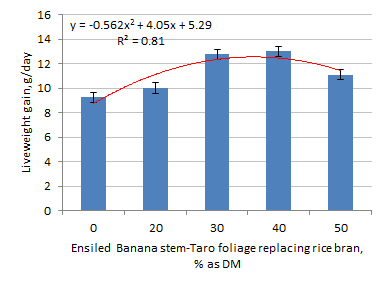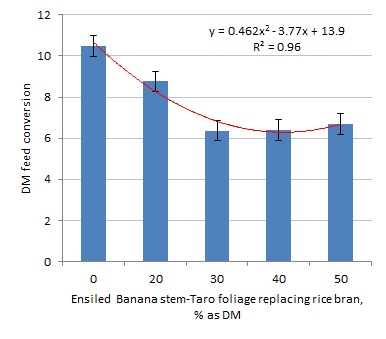|
Back to content |
Livestock-Based Farming Systems, Renewable Resources
and the Environment |
|
Effect of ensiled product made from banana stem and taro foliage on the
growth performance of common ducks
Dao Thi My Tien, Ngo Thuy Bao Tran*, Bui Phan Thu
Hang* and T R Preston**
Faculty of Agriculture and Natural Resources, An Giang
University, Vietnam
dtmtien@agu.edu.vn
Abstract
120 common
ducks at 21 days old were used for an experiment that was carried out to
evaluate the effect of ensiled product made from banana stem and taro foliage on
the growth performance. The experiment was designed in CRD (Completely
Randomized Design) with five treatments and three replicates. The treatments
were based on percentages of the silage of banana stem and taro foliage
(BT) (ensiled 50:50 ratio, DM basis) and rice bran (RB) in the proportions of 0,
10, 20, 30, 40 and 50% (BT) of the diet.
DM
intake decreasedd and DM feed conversion was improved when the banana stem-taro
silage replaced rice bran (Figures 1 and 3). Livewe eight gain showed a positive
curvilinear response witht heoptimu at between 30 and 40% decrease, Livve
weight ggain increased curvilinearly with the optimum between 30 and 40% banana
stem-taro silage in the diet (Figure 2).
 |
 |
| Figure 1. Trends in DM intake as the ensiled mixture of banana
stem and Taro foliage replaced rice bran in the diet of common ducks |
Figure 2. Trends in live weight gain as the ensiled mixture of
banana stem and Taro foliage replaced rice bran in the diet of
common ducks |
 |
|
| Figure 3. Trends in DM feed conversion as the ensiled mixture of
banana stem and Taro foliage replaced rice bran in the diet of
common ducks |
|
Key words:
common ducks, banana stem and taro foliage, feed intake, feed conversion.


